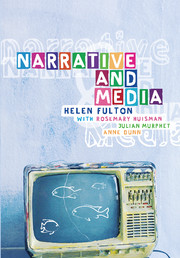Book contents
- Frontmatter
- Contents
- Figures and tables
- Contributors
- Acknowledgements
- 1 Introduction: the power of narrative
- Part 1 The basics of narrative theory
- Part 2 Film as narrative and visual mode
- Part 3 Television: narratives and ideology
- Part 4 Radio and print journalism
- Part 5 Popular print culture
- 18 Magazine genres
- 19 Advertising narratives
- 20 Conclusion: postmodern narrative and media
- Glossary
- Bibliography
- Index
18 - Magazine genres
Published online by Cambridge University Press: 05 June 2012
- Frontmatter
- Contents
- Figures and tables
- Contributors
- Acknowledgements
- 1 Introduction: the power of narrative
- Part 1 The basics of narrative theory
- Part 2 Film as narrative and visual mode
- Part 3 Television: narratives and ideology
- Part 4 Radio and print journalism
- Part 5 Popular print culture
- 18 Magazine genres
- 19 Advertising narratives
- 20 Conclusion: postmodern narrative and media
- Glossary
- Bibliography
- Index
Summary
‘Print culture’ is a term used to describe the social practices associated with the use of print. The printing press was invented in the late fifteenth century, but ‘print culture’ did not develop overnight. Early practitioners understood the value of the printing press as a reproductive tool, compared to the laborious and inaccurate practices of copying manuscripts by hand. However, they did not immediately change their practices of layout and text organisation; that is, the earliest printed books look like manuscripts. But over time, from the new possibilities that print offered – a new authorial control of the physical appearance of the text, a new mode of economic organisation for the distribution of large print runs – an early ‘print culture’ began to emerge.
This culture continues to change and develop in changing social contexts. It meant – and means – the social recognition of new textual objects, associated with new modes of production and interpretation of meaning. The study of narrative in print culture has in most cases focused on the textual object, ‘the novel’, as part of the study of ‘literature’, or literary discourse, which typically includes those uses of language classified as having a ‘high’ social value. In contrast, the study of ‘the media’ has focused attention on the phenomenon of the mass audience, and hence pointed to those textual objects that are ‘popular’; that is, have wide distribution and consumption.
- Type
- Chapter
- Information
- Narrative and Media , pp. 271 - 284Publisher: Cambridge University PressPrint publication year: 2005



